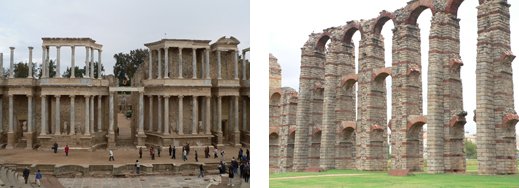|
Merida and its Roman MonumentsHow to get there: From Caceres, take the E-803 (A-66) highway in the direction of Seville, which gets you into Merida in about one hour. Emerita Augusta, or Merida as it is called these days, was the capital of the Roman province Lusitania, and it shows! There is a large Roman theater that is still used for performances (the façade is pictured on the left), an aqueduct (pictured on the right) that was part of a water-supply system, an amphitheatre, some temples, and a rather beautiful elongated Roman bridge over the Guadiana river. The newly built Museo Nacional de Arte Romano (national museum of Roman art) is exceptional (the building as well as the content), as are the large floor mosaics in the Amphitheatre House. As in so many southern Spanish cities, there is an Alcazaba (citadel) as proof of the Moorish presence in the 9th century. The modern town does not offer much beauty, with the exception of the very pleasant Plaza de Espana and environment that serves as the social center of town and that is a very nice place to stroll around or sit for a drink. 
Where to stay and dine
Next stop on your itinerary:
Zafra
|
